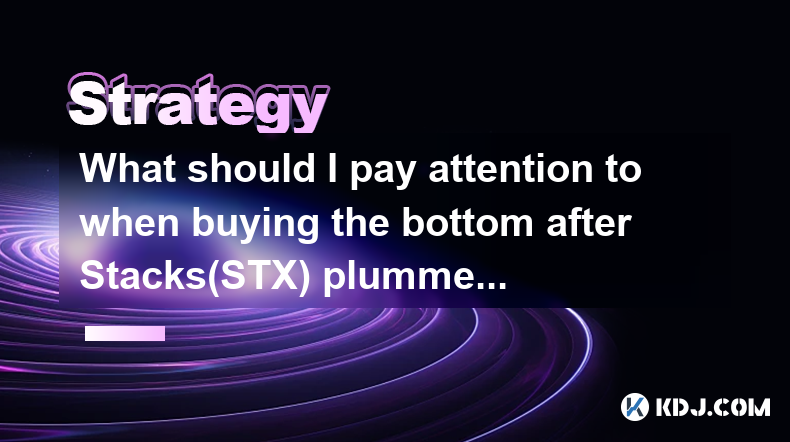-
 bitcoin
bitcoin $114684.631706 USD
-0.87% -
 ethereum
ethereum $4228.677447 USD
1.58% -
 bnb
bnb $1294.880693 USD
-1.16% -
 tether
tether $1.000819 USD
-0.02% -
 xrp
xrp $2.605138 USD
2.79% -
 solana
solana $209.908690 USD
5.89% -
 usd-coin
usd-coin $0.999903 USD
-0.03% -
 dogecoin
dogecoin $0.213423 USD
2.93% -
 tron
tron $0.322721 USD
-0.10% -
 cardano
cardano $0.727247 USD
3.66% -
 hyperliquid
hyperliquid $42.339456 USD
6.05% -
 chainlink
chainlink $19.910811 USD
5.16% -
 ethena-usde
ethena-usde $1.000557 USD
0.00% -
 stellar
stellar $0.349734 USD
2.69% -
 bitcoin-cash
bitcoin-cash $543.848687 USD
-0.21%
What should I pay attention to when buying the bottom after Stacks(STX) plummets? How to build positions in batches?
When STX plummets, investors should analyze the drop's reasons, assess risk-reward, and use DCA to build positions, while monitoring and adjusting their strategy.
May 04, 2025 at 03:09 am

When the price of Stacks (STX) plummets, many investors look to buy the bottom, hoping to capitalize on the subsequent recovery. However, this strategy involves significant risks and requires careful consideration. This article will guide you through the key factors to pay attention to when buying the bottom after a STX plummet and how to build positions in batches effectively.
Understanding the Reasons Behind the Plummet
Before diving into buying the bottom, it's crucial to understand why the price of STX has plummeted. Price drops can be due to various factors such as market-wide corrections, negative news affecting the project, or technical issues within the Stacks ecosystem. Analyzing these reasons can help you determine whether the drop is a temporary dip or a sign of more significant problems.
To understand the reasons behind the plummet, you should:
- Monitor news and announcements related to Stacks. Check official channels and reputable crypto news outlets for any updates that might have triggered the price drop.
- Analyze market sentiment using tools like social media sentiment analysis and crypto community forums. This can give you insights into how other investors are reacting to the situation.
- Review technical indicators on trading charts. Indicators like the Relative Strength Index (RSI) or Moving Average Convergence Divergence (MACD) can help you understand if the asset is oversold or if there are signs of a potential reversal.
Assessing the Risk-Reward Ratio
Buying the bottom after a plummet involves a high level of risk. It's essential to assess the risk-reward ratio before making any investment decisions. This involves evaluating the potential upside of STX against the risk of further price declines.
To assess the risk-reward ratio, consider the following:
- Evaluate the historical performance of STX. Look at past price movements and recoveries to gauge how the asset has reacted to similar situations.
- Consider the overall market conditions. If the broader crypto market is in a bearish trend, it might be more challenging for STX to recover quickly.
- Set clear profit targets and stop-loss levels. Determine at what price you would consider selling for a profit and at what price you would cut your losses to protect your capital.
Building Positions in Batches
Building positions in batches, also known as dollar-cost averaging (DCA), can help mitigate the risk of buying the bottom after a plummet. This strategy involves spreading out your investment over time rather than investing a lump sum at once.
Here's how you can build positions in batches for STX:
- Determine your total investment amount. Decide how much money you are willing to invest in STX over a specific period.
- Divide your investment into smaller, equal portions. For example, if you plan to invest $1,000 over four weeks, you would invest $250 each week.
- Set a schedule for your investments. Choose specific dates or intervals at which you will buy STX. This could be weekly, bi-weekly, or monthly, depending on your strategy.
- Execute your purchases on schedule. Regardless of the current price of STX, stick to your schedule and buy the predetermined amount at each interval.
Monitoring and Adjusting Your Strategy
Once you've started building your positions in batches, it's important to monitor the performance of STX and adjust your strategy as needed. The crypto market is highly volatile, and what works today might not work tomorrow.
To monitor and adjust your strategy effectively, consider the following:
- Regularly review the price and performance of STX. Use trading platforms and charting tools to keep an eye on how the asset is moving.
- Stay updated on news and developments related to Stacks. Any new information could impact the price and your investment strategy.
- Be prepared to adjust your batch sizes or schedule. If STX starts to recover quickly, you might want to increase your investment amounts. Conversely, if the price continues to fall, you might need to reduce your exposure.
Using Technical Analysis to Time Your Entries
Technical analysis can be a valuable tool when buying the bottom after a plummet. Using technical indicators can help you time your entries more effectively and potentially increase your chances of buying at a favorable price.
Here are some technical analysis tools you can use:
- Support and resistance levels. Identify key support levels where STX might find a bottom and resistance levels where it might face selling pressure.
- Candlestick patterns. Look for bullish reversal patterns like the hammer or morning star, which could signal a potential bottom.
- Oversold indicators. Use indicators like the RSI to identify when STX is oversold, which might suggest a good entry point.
Managing Your Emotions
One of the biggest challenges when buying the bottom after a plummet is managing your emotions. Fear and greed can cloud your judgment and lead to poor investment decisions.
To manage your emotions effectively, consider the following:
- Stick to your predetermined strategy. Avoid making impulsive decisions based on short-term price movements.
- Set realistic expectations. Understand that not every investment will be a winner, and be prepared to accept losses if necessary.
- Take breaks from monitoring the market. Constantly watching price movements can lead to stress and emotional decision-making.
Frequently Asked Questions
Q: How do I know if the price drop in STX is temporary or a sign of more significant issues?A: To determine whether the price drop in STX is temporary or indicative of deeper issues, you should analyze the reasons behind the drop. Look for any negative news or developments related to Stacks, monitor market sentiment, and review technical indicators. If the drop seems to be driven by short-term factors and the fundamentals of the project remain strong, it might be a temporary dip.
Q: Can I use automated trading bots to buy the bottom after a STX plummet?A: Yes, you can use automated trading bots to execute your strategy of buying the bottom after a STX plummet. However, you'll need to set up the bot with specific parameters and rules based on your analysis and risk tolerance. Keep in mind that while bots can help with execution, they won't replace the need for thorough research and strategy development.
Q: What should I do if the price of STX continues to drop after I start building positions in batches?A: If the price of STX continues to drop after you start building positions in batches, you should stick to your predetermined schedule and investment amounts. However, you should also monitor the situation closely and be prepared to adjust your strategy if necessary. Consider reducing your batch sizes or pausing your investments if the price drop seems to be driven by fundamental issues rather than temporary market fluctuations.
Q: Are there any specific tools or platforms that can help me with building positions in batches for STX?A: Several trading platforms and tools can help you with building positions in batches for STX. Platforms like Coinbase, Binance, and Kraken allow you to set up recurring buys, which can be used to implement a DCA strategy. Additionally, tools like TradingView can provide you with technical analysis and charting capabilities to help you time your entries more effectively.
Disclaimer:info@kdj.com
The information provided is not trading advice. kdj.com does not assume any responsibility for any investments made based on the information provided in this article. Cryptocurrencies are highly volatile and it is highly recommended that you invest with caution after thorough research!
If you believe that the content used on this website infringes your copyright, please contact us immediately (info@kdj.com) and we will delete it promptly.
- XRP Price Prediction: Weekend Rollercoaster or Rally?
- 2025-10-12 08:45:16
- Bittensor (TAO): Super Bullish Signals Point to Potential 2x Rally
- 2025-10-11 10:25:12
- Silver Price Correction: Navigating the Dip & Identifying Key SEO Keywords
- 2025-10-11 10:25:12
- Decoding Crypto Trends: Bittensor's Bull Run, Cardano's Dip, and LivLive's Presale Buzz in 'Uptober 2025'
- 2025-10-12 08:45:16
- MoonBull: The Crypto Meme Coin Promising 1000x Gains?
- 2025-10-11 10:30:01
- Crypto Payroll Revolution: Stablecoins, Altcoins, and the Future of Salary Payments
- 2025-10-11 10:30:01
Related knowledge

Practical parameter settings for a Bitcoin multi-timeframe moving average system
Sep 18,2025 at 10:54pm
Optimizing Timeframe Combinations for Bitcoin Trading1. Selecting appropriate timeframes is crucial when building a multi-timeframe moving average sys...

How can I filter out false breakouts in Dogecoin high-frequency trading?
Sep 22,2025 at 01:00am
Understanding False Breakouts in Dogecoin Trading1. A false breakout occurs when Dogecoin's price appears to move beyond a defined support or resistan...

Techniques for identifying tops and bottoms in the Bitcoin on-chain NVT model
Sep 20,2025 at 07:54pm
Understanding the NVT Model in Bitcoin Analysis1. The Network Value to Transactions (NVT) ratio is often described as the 'P/E ratio' of the cryptocur...

What does the surge in open interest in Bitcoincoin futures mean?
Sep 20,2025 at 11:18pm
Understanding the Surge in Dogecoin Futures Open Interest1. A surge in open interest within Dogecoin futures indicates a growing number of active cont...

How can I use the Ethereum USDT premium to gauge market sentiment?
Sep 18,2025 at 11:55pm
Understanding the Ethereum USDT Premium1. The Ethereum USDT premium refers to the price difference between USDT (Tether) traded on Ethereum-based plat...

What should I do if Ethereum staking yields decline?
Sep 20,2025 at 06:18am
Understanding the Causes Behind Declining Ethereum Staking Yields1. The Ethereum network transitioned to a proof-of-stake consensus mechanism with the...

Practical parameter settings for a Bitcoin multi-timeframe moving average system
Sep 18,2025 at 10:54pm
Optimizing Timeframe Combinations for Bitcoin Trading1. Selecting appropriate timeframes is crucial when building a multi-timeframe moving average sys...

How can I filter out false breakouts in Dogecoin high-frequency trading?
Sep 22,2025 at 01:00am
Understanding False Breakouts in Dogecoin Trading1. A false breakout occurs when Dogecoin's price appears to move beyond a defined support or resistan...

Techniques for identifying tops and bottoms in the Bitcoin on-chain NVT model
Sep 20,2025 at 07:54pm
Understanding the NVT Model in Bitcoin Analysis1. The Network Value to Transactions (NVT) ratio is often described as the 'P/E ratio' of the cryptocur...

What does the surge in open interest in Bitcoincoin futures mean?
Sep 20,2025 at 11:18pm
Understanding the Surge in Dogecoin Futures Open Interest1. A surge in open interest within Dogecoin futures indicates a growing number of active cont...

How can I use the Ethereum USDT premium to gauge market sentiment?
Sep 18,2025 at 11:55pm
Understanding the Ethereum USDT Premium1. The Ethereum USDT premium refers to the price difference between USDT (Tether) traded on Ethereum-based plat...

What should I do if Ethereum staking yields decline?
Sep 20,2025 at 06:18am
Understanding the Causes Behind Declining Ethereum Staking Yields1. The Ethereum network transitioned to a proof-of-stake consensus mechanism with the...
See all articles










































































